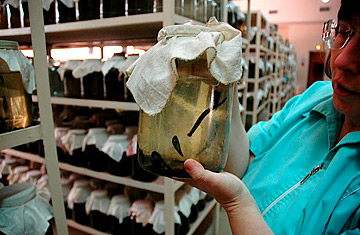
Leeches are bred in a factory near Moscow.
Udelnaya is a sleepy town southeast of Moscow, full of muddy roads lined with brightly painted wooden houses. Behind a frozen stream there is one large brick building that looks a little out of place. Inside are hundreds of rows of jars exuding an unpleasant smell. They are full of Hirudo medicinalis, more commonly known as leeches. But few locals are turning up their noses at the presence of so many blood-sucking annelids. Leeches are the flourishing industry in Udelnaya, a bright spot in a Russian economy hurtling into recession.
Russia breeds 10 times more leeches than the rest of the world combined, most of them raised at the International Medical Leech Center at Udelnaya. It is an institution that has existed since 1937, producing 3 million leeches annually. It is now taking advantage of the growing popularity of leech therapy, also known as Hirudotherapy, around the world. Demi Moore last year spoke about the cleansing effects of leeches; Britain's National Health Service buys 50,000 bloodsuckers every year; the U.S. Food and Drug Administration approved leech therapy in 2004 because they proved beneficial in increasing blood circulation for patients who have had skin grafts. (See a brief history of leech lore.)
Today the center sells the leeches to plastic surgeons, who put them on wounds to reduce the chance of scarring, to dentists, who apply them on gums to reduce swelling, and even to gynecologists, who use them to treat sexually transmitted diseases (Yes. You imagine right.). The oral cavity of the leech is rich with an anticoagulant, which allows the animal to feed continuously on blood but which also delivers the anti-clotting substance more effectively to the area of a wound than would a small injection puncture. Indeed, leeches are used very much like syringes. After a leech is used on a patient it has to be killed. "It's like a disposable syringe, it isn't good sanitary practice to use it twice," says Gennady Nikonov the director of the Leech Center. (See 10 Ideas Changing the World Right Now.)
Retailing for about 100 rubles each (or close to $3), Russians can buy them at wholesale at Udelnaya for half the price. For most Russians, medicinal leeches are not looked upon as exotic or primitive. Under Communist rule, leeches were readily available for sound therapeautic purposes. "It was mandatory for each pharmacy to have 25 leeches in stock at a time," says Nikonov, who has worked at the Center for 19 years. He is very proud that the rest of the world is now catching up to Russia. (Check out the story of a modern-day exorcist.)
Still, leeches aren't pretty. And neither do they smell nice. The odor from the Center's laboratory is like stale meat in a dirty restroom. It can be detected from far away and becomes close to unbearable when approaching the jars full of leeches — all various hues of red and yellow depending on when they were last fed. "Leeches urinate non-stop for three days after they are fed," explains Elena Titova, the head of laboratory production, who has worked at the center for 25 years. "You have to clean their jars very frequently during this time; otherwise they poison themselves with their own waste."
The other component of the stench is blood. "We feed them certified cattle blood," said Nikonov. "And on national holidays we give them veal blood as a treat." For Nikonov, who was trained as a chemist, breeding the leeches is an art. "It looks like it's just a jar full of water, but there are millions of chemical processes going on."
Nikonov believes women are more nurturing than men when it comes to the creatures; and, at the laboratory, each employee raises her own batch of leeches from start to finish. "That way if something goes wrong and thousands of leeches die no one can blame anyone else," says Titova. According to her, leeches are very attached to their owners. She organizes her vacation around their feeding times so that no one else interferes with her lot. When a leech is about to be sold, it has to be starved for three months to be at its most effective.
Some of the leeches go into Nikonov's own skin care range "Bio Energy," which is made at the Center. The most expensive product, an anti-aging cream, contains dried, freshly-hatched larvae and retails for 47,000 rubles ($1,300) for 15 grams. The idea for the cosmetic range came after the collapse of Communism, when pharmacies were no longer required to sell leeches. "We had no money and the staff would go several months without wages," says Nikonov. "We had too many leeches and we wanted to try and create something exciting and profitable." Nikonov explains that the deconstructed leeches become ingredients in a cream, helping it the skin's surfce to improve circulation of oxygen, fats and protein. All this, he claims, leads to younger looking skin. (See pictures of Russia's patriotic youth camps.)
The biggest export market for the Center's leeches is France. Nikonov, however, says that he remains very selective about his clientele. "We are careful about who we export them to," he says. "I know in certain cuisines people put the leech on a goose. They wait until it gets fat on the goose blood and then fry the leech like it's a sausage. This is considered a delicacy. I feel sorry for the leech. They should not be used this way."
